Reminder – our 2023 Platte River Prairies Field Day is THIS SATURDAY, July 8. We will have sessions running between 7am and about 2:30pm and you can stop by anytime. This is a free, family-friendly event. Here is the final (?) schedule for the day. Please RSVP (email address in the link) if you plan to come so we can be prepared. The weather forecast looks fantastic!
But anyway, here’s today’s post. It’s a little long (but with lots of photos). If you restore or manage prairies, though, I hope it’ll be thought-provoking and helpful.
How much influence does land management have on prairie plant communities? Two research projects from the University of Nebraska-Lincoln have shed some light on the relative importance of management versus ‘abiotic’ factors such as soil texture, and nutrient levels (especially nitrogen). This week, I was noticing the visual evidence of what Rae Powers and Katharine Hogan found during their graduate research. You can read more about their projects at the end of this post.
Take a look at the photo below. (If you click on these photos, you’ll get much bigger and more clear versions. If you’re reading this within an email, click on the title of the post to open it online and then you can click on images.)

The plant community in the above photo is visually dominated by invasive grasses – smooth brome and annual bromes – with some non-native mullein plants in the background. Yuck.
The next photo shows the same site, not far from where the first photo was taken. The second photo is dominated by mullein plants with an understory of annual bromes. If you look closely you can see some native grasses and some ‘weedy’ native wildflowers like hoary vervain and yarrow.
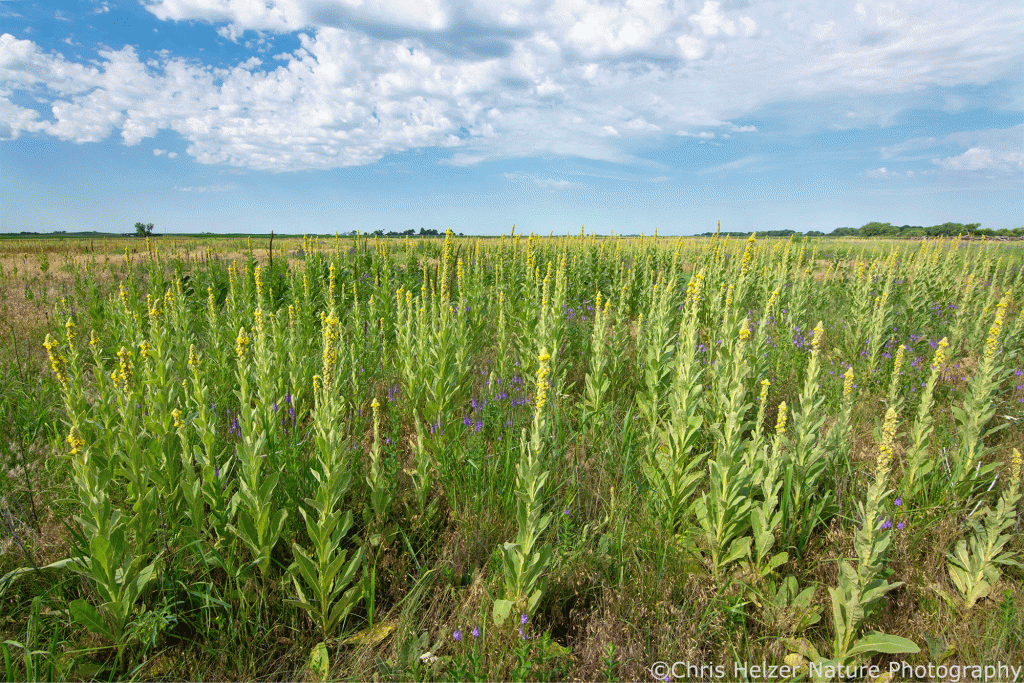
If you have much experience with prairie management and restoration, you’ve probably formed an opinion of the prairie planting they’re in, which is over 20 years old. That opinion is probably not very positive. This prairie is a mess, right?
Ok, here’s photo #3:

Now we’re talking! This looks way better. It’s visually-dominated by native species, including sand lovegrass, stiff sunflower, big bluestem, roundheaded bushclover, and sundrops (Calylophus serrulatus). Since I took the picture, I can tell you the scene also features purple prairie clover, shell-leaf penstemon, and Junegrass, among other other plant species. It appears to have nice plant diversity and very few invasive plants.
One more photo:

The fourth photo is pretty grassy, but the grasses appear to be mostly native species. Lots of big bluestem, Indiangrass, switchgrass, little bluestem, and others. Not a great place for bees and butterflies to find nectar, but decent habitat cover for some wildlife species.
If you’ve glanced at the captions of those photos, this next statement won’t be a surprise. All four of those photos were taken on the same day from the same prairie planting. What in the world could explain the huge differences between the conditions across that single site? The site, by the way, is about 64 acres in size and was planted with 218 species in late 2001 and early 2002. Here’s a map, showing both the 2002 planting and another one planted in 2000 that I’ll talk about shortly. You can also see a remnant prairie to the west (left) of both those plantings.
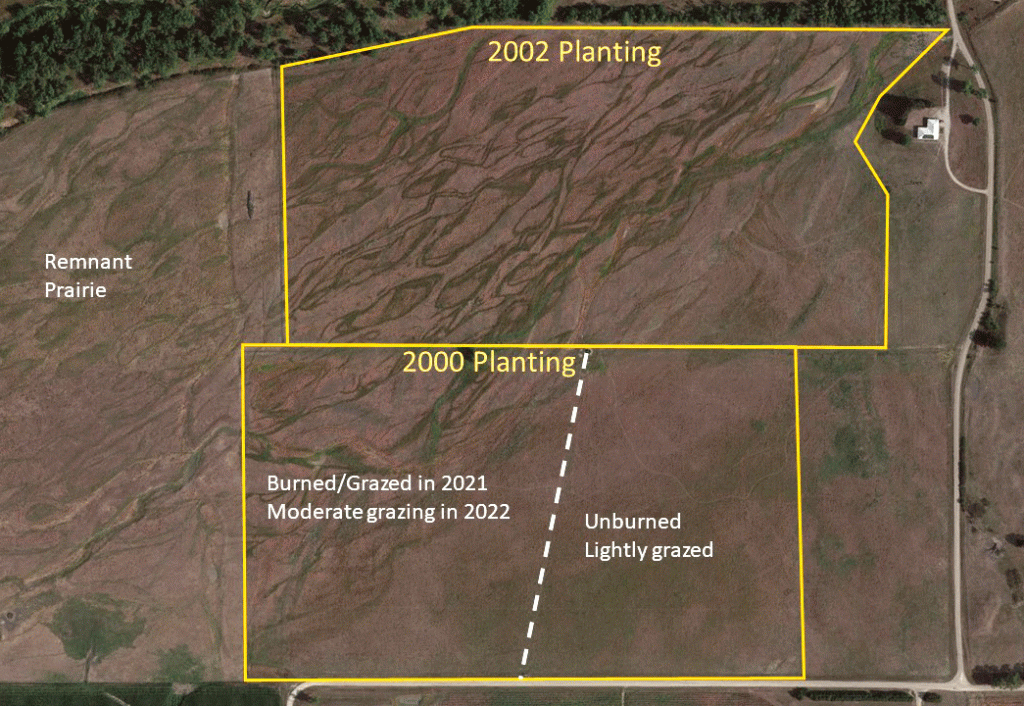
See all those patterns in the 2002 planting? They show the alluvial soils that underlay both the remnant (unplowed) and restored (replanted from crop field) portions of this area. In dry years (as in when this aerial image was created) you can really see the old river channels and sandbars upon which today’s prairie grows.
Long ago, the 2002 planting site was leveled for farming. They made it flat so they could irrigate it by running water down the rows. During the leveling process, they knocked the tops off the old sandbars (including the topsoil that centuries of prairie growth had generated) and pushed the soil into the old river channels. As a result, the dark green streaks in the above map have multiple layers of topsoil and the brown areas between have very little.
The differences in soil texture, nutrients (especially nitrogen), and organic matter across that old alluvial network have tremendous influence on plant communities – especially in dry years. Here’s one more photo of the same 2002 planting that really illustrates that. The green stripe down the middle is dominated by native grasses like big bluestem and native forbs like stiff and Maximilian sunflowers (and lots of others). The areas on each side are full of annual bromes and ‘weedier’ native plants like tall dropseed, daisy fleabane, hoary vervain, and others, as well as a few mullein plants.

There’s no difference in management between the green and brown areas in the above photo. What’s driving the starkly different plant communities is mainly the soil pattern beneath them (interacting with weather patterns). Among other things, the higher organic matter beneath the green areas have buffered plants much better from the effects of the drought over the last couple years. Often, sandier soils with lower nitrogen foster the highest plant diversity, but drought interactions complicate that and our plant communities can look very different from year to year.
It’s definitely messy, but not necessarily in a bad way. In fact, once you get used to it, it’s fascinating to watch over time. In years of abundant rainfall, the ‘droughty’ areas are pretty green and have decent plant diversity, including both native and non-native plants. In dry years, the soil contrasts are exacerbated and noticeable – like they are this year.
.
It’s taken me a long time to accept that prairies I’ve planted have areas that are pretty and diverse (as I’d envisioned while harvesting seed) and others that are, well, less so – especially in some years. That happens regardless of matter how well we harvested seed, how diverse our seed mixes were, and how diligent we were about site preparation and post-planting management. Some soil patches favor dense grass, others favor opportunistic and/or invasive plants, and others foster diverse plant communities.
At the Platte River Prairies, we’re lucky that those soil variations are intermixed, which automatically creates a lot of heterogeneity across every prairie. In both remnants and restorations, there are dry and ‘weedy’ patches, patches of dense grass, and patches of high plant diversity with lots of the wildflowers we worked hardest to establish. As a whole, all that variety creates lots of habitat for lots of different species.
Now, that doesn’t mean management doesn’t matter. Plant composition and diversity are not pre-ordained by soils, they’re just somewhat constrained by them. Both Rae and Katharine found that while abiotic factors controlled a lot of the variation in plant composition, management had strong impact on plant species richness and evenness (the abundance of species relative to each other).
Here are some visual examples of how that plays out on the ground. The following images show scenes from the 2000 Prairie Planting just to the south of the 2002 Planting we were just looking at.
The first two images below show a portion of that prairie that was unburned and lightly grazed for a couple years before being completely ungrazed this year. They are in a portion of the site that favors plant diversity (sandy soils with low nitrogen) but management has favored grass dominance over the last few years. That management, though, has also encouraged plant species that cattle especially like to eat, including entire-leaf rosinweed (Silphium integrifolium) and Canada milkvetch (Astragalus canadensis).

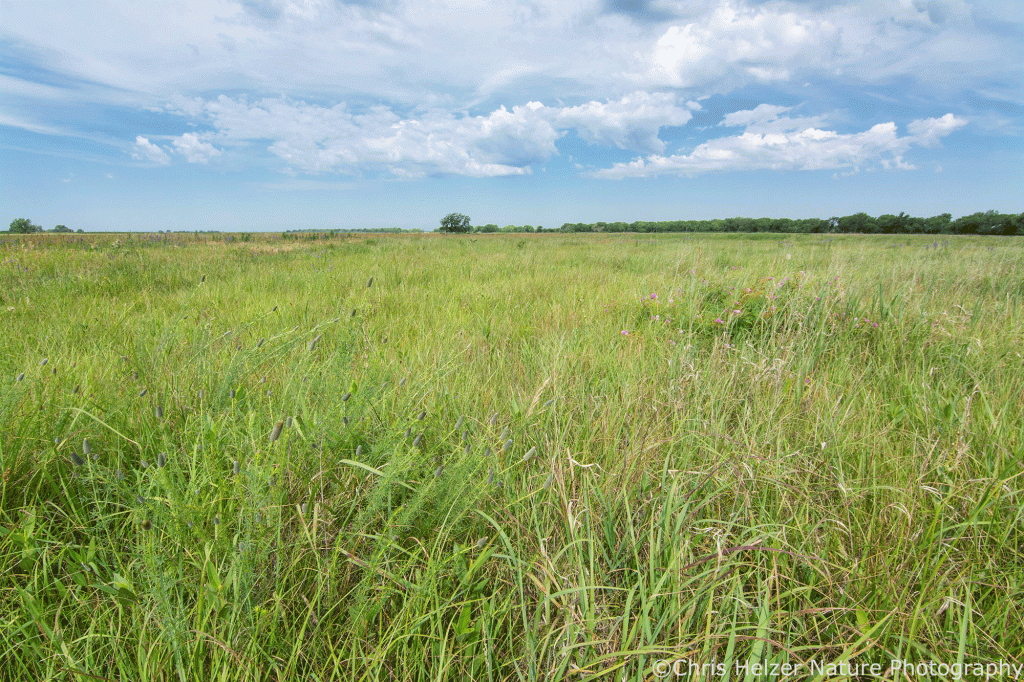
Now, here are three photos taken a short distance away, in the same general soil type on the west side of the dotted line in the map above. The prairie here was burned in 2021 and grazed hard all that year. Last year, it was grazed fairly lightly and is ungrazed this year. The impacts of that fire and (especially) grazing from 2 years ago is still very evident. Grasses are much less dominant here than the lightly grazed area just to the east, and the diversity and abundance of flowers is much higher.
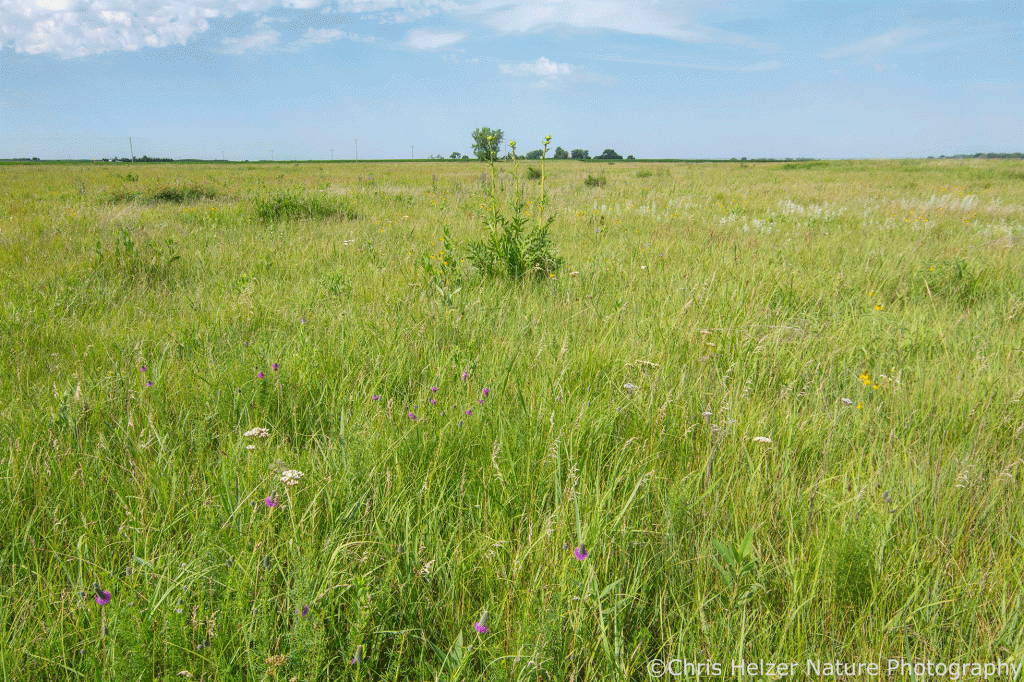
In the above photo, there is an abundance of purple prairie clover in the foreground, along with yarrow, stiff sunflower, compass plant, rosinweed, cudweed sagewort, upright prairie coneflower, and other wildflowers. In the photo below, Junegrass is having a great year, probably because of the reduced vigor of big bluestem and other taller grass species.
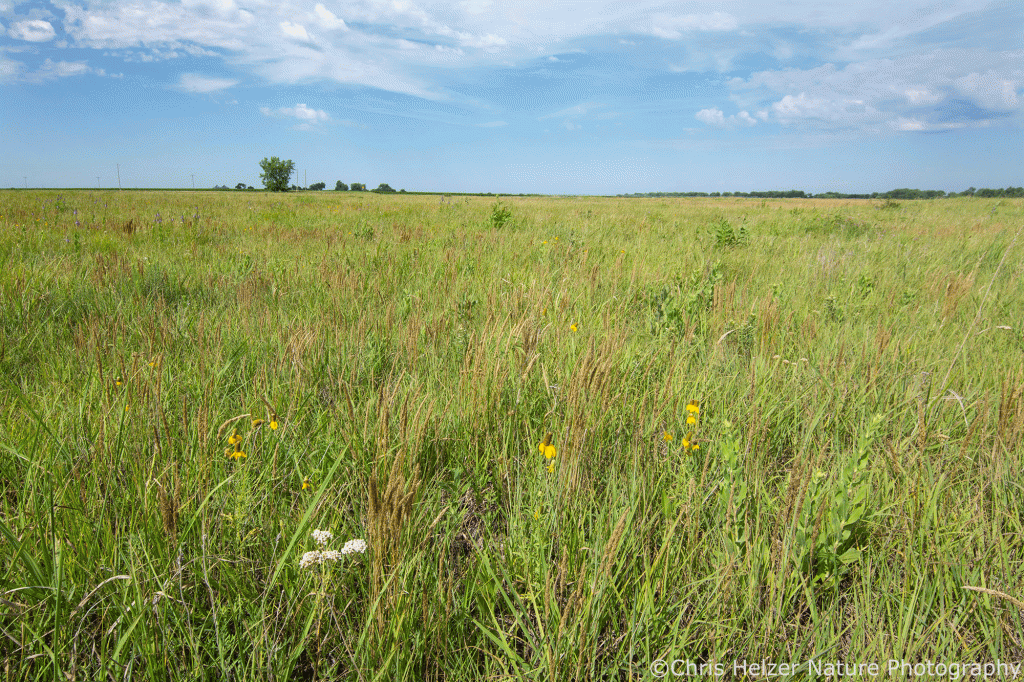
The soils aren’t driving the differences seen in these last 5 photos – management is. Those management impacts are mostly temporary, though. If we don’t burn or graze that west area where flowers are abundant this year, we’ll likely see fewer flowers and more grass dominance next year. Cody is planning a summer burn on part of the east area where grasses are currently dominant, and then hopes to let cattle in to graze the aftermath of that burn. That will push that area toward a higher abundance of wildflowers for a while.
.
Basically, what we’re seeing here is that soils set the stage for a plant community and determine what plant species are best adapted to grow in a particular place. Management, then, helps determine the relative abundance and dominance of those species (interacting with weather patterns). Grazing on our sites tends to foster higher plant diversity (especially during recovery periods after season-long grazing bouts) and changes the competitive environment.
Some plant species thrive best when an area hasn’t been grazed for a while. Others respond most positively during or shortly after grazing. By cycling through periods of grazing and rest, we hope we’re giving all those species a chance to hang around (and our long-term data supports that).
The data and patterns I’m talking about here are only part of what Rae did for her Master’s degree and Katharine did for her PhD dissertation (not yet available). Their work described what they saw here at the Platte River Prairies and nearby prairies at the Crane Trust. The broad idea that soils constrain plant composition and management influences plant diversity and relative abundance probably extrapolates to most grasslands. The patterns might be a little more obvious in our alluvial soils, though, especially on previously-leveled crop fields planted to prairie.
If you’re restoring/reconstructing prairies or managing them, I’m hoping this information helps you better understand your sites and what’s happening there. For me, it’s been helpful to accept that the impacts of our land management (and restoration) practices are limited. Prairies are really dynamic but the potential variation within a particular plant community is restricted by soils and heavily influenced by weather patterns.
As a result, the old adage, “only worry about what you can control” applies here. Don’t beat yourself up because parts of your site are less ‘pretty’ than others and/or more prone to invasion than others. Instead, explore and document the possible range of variation within plant communities in different locations. Some areas might be able to facilitate tremendous plant diversity, while others might favor a few species over all others or fluctuate wildly based on annual rainfall patterns. Once you know the limitations of particular areas, you can make (and evaluate) stewardship decisions appropriately.
I’m going to end by sharing two more photos from the 2000 planting. Prairies can look very different from year to year. They’re incredibly dynamic and adaptable (and not just the plant communities). These two photos are representative of how the 2000 planting looked in September 2022 and in August 2017. In both cases, the photos were taken a year after the site was burned and grazed all season. One was a drought year (2022) and the other was a year of at least reasonable moisture (2017). Both are within the range of variation possible for that site.


Have fun. Experiment. Find out what range of variation your soils can provide and then play in that space.

Ć
It’s posts like this that make me trust what the Nature Conservancy is doing in the Northern Great Plains! Thanks, Chris. We all need a reminder about the things discussed in this post.
Excellent post, especially well introduced with your photos of the contrasting vegetative communities.
Stephanie
Thank you, Chris, for what you and other scientists do in a culture so prone to denigration of facts and data that contradict their opinions.
I visited Dinesen prairie yesterday – a native remnant black soil prairie near Harlan. I was struck by the impressive floral diversity on the site, apparently maintained only by burning. This seems to run a bit counter to the idea that absence of grazing tends to lead to grass dominance over time. Are there some soils that seem to favor a more stable mix of plants over time maintained just by burning? Or is that just a feature of remnant prairies that we don’t fully understand?
Hi Patrick,
Yes, if the plant community were the only objective, annual/frequent burning seems to maintain a pretty diverse community of plants in some locations. I’m not sure what soil/precipitation/other factors make that work differently in different locations, but there seems to be a pretty strong east/west difference. Eastern sites tend to maintain plant diversity better with fire, while western (Nebraska, Kansas, etc.) prairies in the Central U.S. tend to become grassier with frequent fire and no grazing.
Of course, plants are only one of many important taxa in prairies, and frequent burning can have serious impacts on those other taxa, so there are some key tradeoffs to consider. But the idea that grazing is necessary to prevent grass dominance is definitely not a given at many sites.